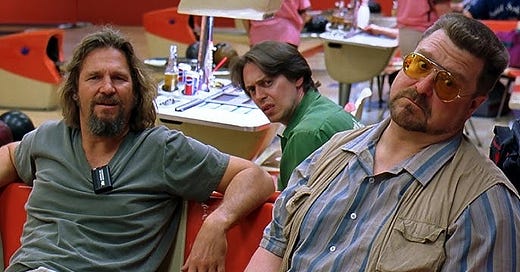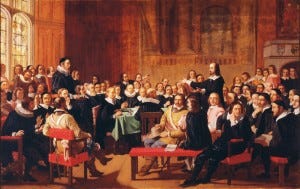From Kids to Bowling Leagues
I’ve been reading a lot this summer, as a volatile capital markets/interest rate environment has made new projects take much longer to pursue. I recently finished a book, The Upswing, by Robert Putnam and Shaylyn Romney Garrett, that provided some insight into both where we are as an American society as well as the kind of community development work we write about in Topophilia.
What are the conditions for a thriving democracy?
In college, I took a transformative course, History of the American Revolution, with Professor Stephen Innes. This course shaped my worldview as much as any other. Professor Innes’ thesis was that the strength of civic society in pre-Revolutionary War New England—churches, schools, militias, town councils, all independently organized—created an "ecosystem" that was an important soil/groundwork to cultivate democracy. This concept of a self-sustaining, robust civic society resonated deeply with me and laid the foundation for my understanding of community development. In our work today, I often think — what are our investments (and partner investments, and city investments, and others) doing to promote a neighborhood with high social cohesion and trust (if anything?)
As a college student, I followed another course with Professor Innes, The Meaning of Community in America. In this class, we delved into history, fiction, nonfiction, and social science to study where community has succeeded or failed in creating a thriving society. One pivotal book for me Robert Putnam’s "Bowling Alone," which argues that healthy American societies have thrived on high levels of social capital, characterized by networks of civic engagement, trust, and reciprocity.
Bowling Alone: The Collapse and Revival of American Community
We’re entering a world of pain.
Putnam’s "Bowling Alone" highlights how the reduction in people’s civic involvement has led to a fraying of the social fabric. The title of the book comes from the decline in bowling leagues in America from 1960-2000, and how regular and intentional gatherings with your neighbors over bowling leagues (and every other major indicator of association: most notably, in America, dramatically declining church attendance) is crashing.
Decline in Civic Participation: Putnam documents the steady decline in participation in various forms of civic engagement, including voting, attending town meetings, and participating in local organizations.
Erosion of Social Trust: As Americans became less engaged in their communities, trust in one another and in institutions diminished.
Impact on Health and Happiness: The decrease in social capital has been linked to adverse outcomes in public health, education, and overall well-being.
Technological and Social Changes: Putnam attributes part of this decline to technological advancements and changes in social norms that have led to more individualized and less community-oriented lifestyles.
Our Kids: The American Dream in Crisis
Building on the insights from "Bowling Alone," Putnam wrote "Our Kids" about a decade ago. This book traces the implications of the decline in how we think about our community, neighbors, and locality from “we” to “me.” A generation ago, Putnam traces, when people used the phrase “our kids,” they would mean “the kids of our community.” Today, it’s “my specific children.” Our Kids highlights this shift from “we” to “me” with several causes:
Growing Class Divide: Putnam illustrates how the gap between rich and poor has widened, affecting children’s opportunities and outcomes, as well as connectivity between families
Importance of Community Support: He emphasizes that children from affluent families benefit from robust community support, while those from less privileged backgrounds often lack such support.
Role of Social Capital: The book argues that social capital—strong networks of support and engagement—is crucial for the success and well-being of all children (and community problems).
Where we are today
Putnam’s book, The Upswing, compares today (an “I” society with weak civic institutions) to The Gilded Age (Musk, Bezos, Gates are not that different from Rockefeller, Carnegie, Vanderbilt…and political polarization is just as bad!).
The Upswing’s diagnosis is spot-on, its conclusions are, essentially, that re-engaging in communities is necessary for survival. Churches have largely shed membership across the board—with the exception of very large churches that are more entertainment than community centers. Some churches, however (including very impactful ones that I’ve been a part of ) break the congregation up into “small groups” that provide regular support and connection. A small group I joined through a church 15 years ago still impacts my life daily.
Connecting with your neighborhood and community via voluntary associations (most frequently, Putnam points out, well-educated Americans do this through kids’ activities, while lower-education-level Americans often do not have the time or structure for kids’ activities) also creates this trust. One of my favorite things in our hometown of Purcellville is a regular, extremely informal, “come as you are” weekly golf league where I’ve seen ages 23 to 83 participate. (The name of the golf league is NBFC…stands for Nobody F* Cares…if you are uptight about your golf score, or anything else…well calm down, mark it zero, and move on.)
Our investments at Blueprint are not going to solve any of these issues…but physical spaces and make a small part. As we think about where we invest, the physical environment of a community matters. The activities at Camp North End in Charlotte-once a big institution (Ford, US military), then abandoned, and now a vibrant space with 15,000 visitors each weekend—is just one example.






